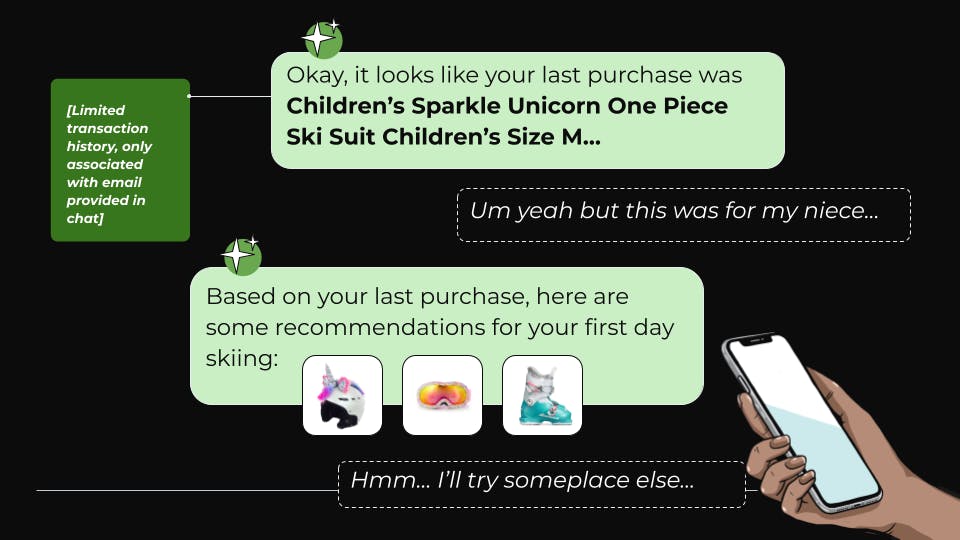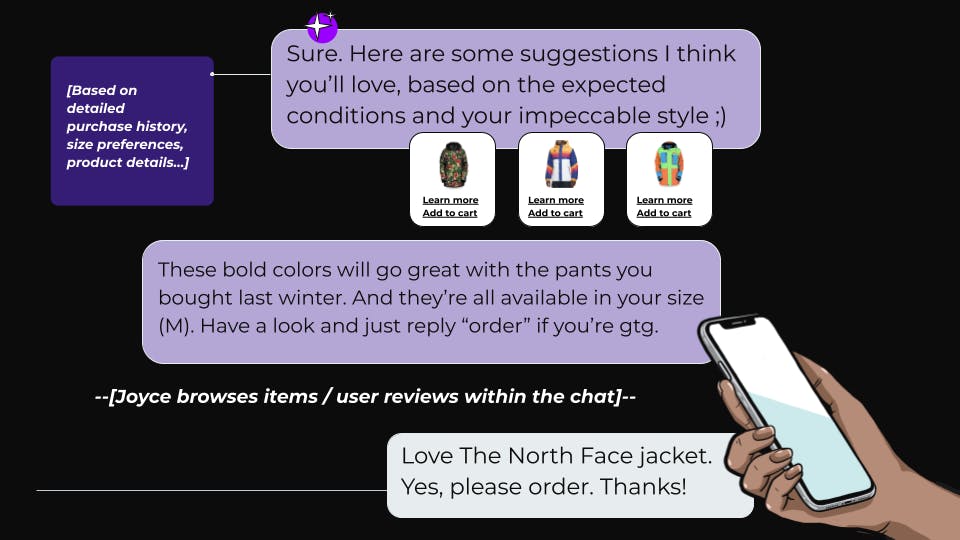The hype around generative AI for marketing is at fever pitch, but for consumer brands there’s a yawning gulf between expectations and reality. Marketers dreaming of offering customers a magical-feeling experience of maximum convenience, tailored just for that individual customer, will find that AI lives or dies on the quality of the underlying data.
AI tools can offer sophisticated personalization, but only if they have the right data to work from. Without that, the AI magic goes clunk.
AI-powered marketing with poor data quality
Let's imagine an AI-driven experience. Say I’m a customer of a general sports apparel and outdoor store, and I’m planning for my upcoming annual winter ski trip. I’m excited to use the personal shopper AI to give me an experience that’s easy and customized to me.
I need to fill in some gaps in my ski wardrobe, so I ask the personal shopper AI to suggest some items to purchase. But the AI is creating its responses based on data about me scattered across the brand’s multiple systems. Without a clear picture of who I am, it asks me for some basic information that it should already know. Slightly annoying… I’m used to entering my info when I shop online, but I was hoping the AI upgrade to the experience would make things easier for me.

Because my data is so disconnected, the AI concierge only has an order associated with my name from two years ago, which was actually a gift. Without a full picture of me, this personal shopper AI is unable to generate accurate insights and ends up sharing recommendations that aren’t helpful.

Ultimately this subpar experience makes me less excited about purchasing from this brand, and I decide to go elsewhere.
The culprit behind a disconnected and impersonal generative AI experience is data quality — poor data quality = poor customer experience.
AI-powered marketing with good data quality
Let’s revisit this outdoor sports retailer scenario, but now imagine that the personal shopper AI is powered by accurate, unified data that has a complete history of my interactions with the brand, from first purchase to last return.
I enter my first question, and I get a super-personalized and friendly response, already starting to create the experience of a one-on-one connection with a helpful sales associate. It automatically references my shopping history and connects my past purchases to my current shopping needs.

Based on my prompts and responses, the concierge provides a tailored set of recommendations to fill in my ski wardrobe, along with direct links to purchase. The AI is then able to generate sophisticated insights about me as a customer and even make predictions about the types of products I might want to buy based on my past purchases, driving up the likelihood of me purchasing and potentially even expanding my basket to buy additional items.

Within the experience, I am able to actually use the concierge to order, without having to navigate elsewhere. I also know my returns or any future purchases will be incorporated into my profile.
Because it knew my history and preferences, Generative AI was able to create a buying experience for me that was super personalized and super convenient. This is a brand I will keep returning to for future purchases.
In other words, when it comes to AI for marketing, better data = better results.
So how do you actually address the data quality challenge? And what could that look like in this new world of AI?
Solving the data quality problem
The critical first element to powering an effective AI strategy is a unified customer data foundation. The tricky part is that accurately unifying customer data is hard due to its scale and complexity — most consumers have at least two email addresses, have moved over eleven times in their lifetimes and use an average of five channels (or if they are millennials or Gen Z, it’s actually twelve channels).
Many familiar approaches to unifying customer data are rules-based and use deterministic / fuzzy matching, but these methods are rigid and break down when data doesn’t match perfectly. This in turn creates an inaccurate customer profile that can actually miss a huge portion of a customer’s lifetime history with the brand and not account for recent purchases or changes of contact information.
A better way to build a unified data foundation actually involves using AI models (a different flavor of AI than generative AI for marketing) to find the connections between data points to tell if they belong to the same person with the same nuance and flexibility of a human but at massive scale.
When your customer data tools can use AI to unify every touchpoint in the customer journey from first interaction to last purchase, the result is a comprehensive customer profile that tells you who your customers are. And, good news, it also tells your AI marketing tools who your customers are.
How data quality in generative AI drives growth
Data quality to power AI provides benefits in three areas:
Customer experiences that stand out — more personalized creative & offers, better customer service interactions, a smoother end-to-end experience, etc.
Operational efficiency gains for your teams — faster time to market, less manual intervention, better ROI on campaigns, etc.
Reduced compute costs — better-informed AI doesn’t need to go back and forth with the user, which saves on racking up API calls that quickly get expensive
As generative AI tools for marketing continue to evolve, they bring the promise of getting back to the level of one-to-one personalization that customers would expect in their favorite stores, but now at a massive scale. That won’t happen on its own, though — brands need to provide AI tools with accurate customer data to bring the AI magic to life.
